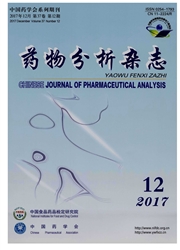

 中文摘要:
中文摘要:
摘要目的:考察大黄、黄柏、赤芍炮制前后化学成分在质和量方面的变化,以探讨中药的炮制机理。方法:利用电喷雾质谱法(ESI—MS)和高效液相色谱法(HPLC—UV),对大黄、黄柏、赤芍炮制前后的化学成分进行详细研究。质谱:电喷雾电离源(ESI),加热毛细管温度为200℃,喷雾电压为4.5kV;液相色谱:色谱柱为Agilent Zorbax C18柱(4.6mm×150mm,5μm),柱温均为28℃。结果:大黄经酒制和醋制后,其化学成分的含量变化较大;黄柏经酒制后巴马汀的含量略有增加,而小檗碱的含量呈下降趋势;盐制对于黄柏的化学成分几乎无影响;赤芍经酒制和炒制后,芍药苷的含量都呈下降趋势。结论:不同炮制方法对化学成分的影响不同,为进一步阐明中药材炮制人药的科学内涵提供了实验依据。
 英文摘要:
英文摘要:
Objective:To analyze the main chemical components existed in the unprocessed and processed Radix et Rhizoma Rhei, Cortex Phellodendri and Radix Paeoniae Rubra. Methods:The analysis was carried out by ESI - MS and HPLC - UV methods. MS: electrospray ionization source, heated capillary temperature of 200 ℃, spray voltage of 4. 5 kV ; LC : Agilent Zorbax C18 column (4. 6 mm × 150 mm, 5 μm ), column temperature 28 ℃. Results: The contents of chemical components in Radix et Rhizoma Rhei were different between samples processed with wine and vinegar;The content of palmatine in Cortex Phellodendri was increased and the content of berberine was decreased in sample processed with wine, but there was no difference between Cortex Phellodendri unprocessed and processed with salt ;The content of paeoniflorin was decreased in processed Radix Paeoniae Rubra. Conclusion:Different processed methods are making a certain different influence on the contents of chemical components in Radix et Rhizoma Rhei, Cortex Phellodendri and Radix Paeoniae Rubra.
 同期刊论文项目
同期刊论文项目
 同项目期刊论文
同项目期刊论文
 期刊信息
期刊信息
